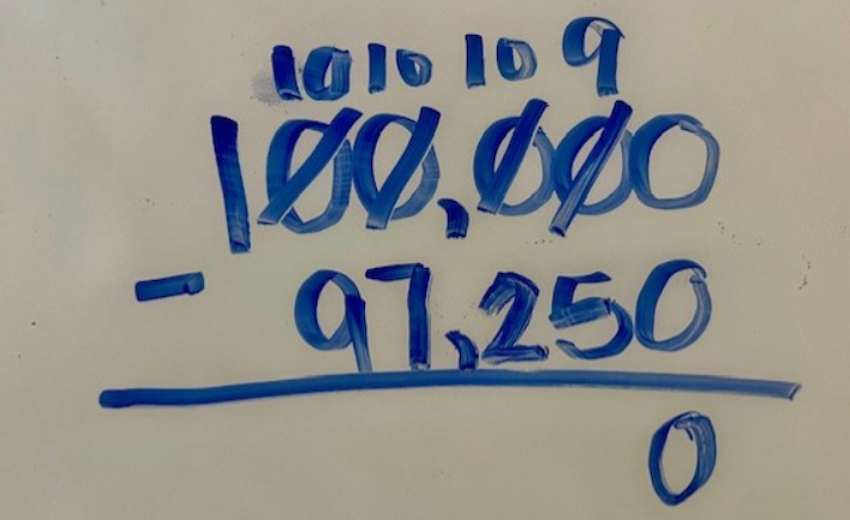
If you’re like me, the first time you heard the term “number talks,” you assumed it referred to simply talking about numbers. Anytime my students and I discussed numbers in the classroom, like when we did fact fluency, I thought we were having a successful number talk. However, there’s more to them than that.
As students in all grades work through increasingly complex computations, they must develop flexibility with numbers and use various strategies to solve a problem. Number talks can be a powerful strategy to help them be successful.
What are number talks?
Number talks are brief classroom conversations of about five to fifteen minutes centered around mentally solving purposefully crafted computations. Whoa. That’s a mouthful, right? Let’s break that down a bit.
- They’re brief. Number talks should be no longer than 15 minutes.
- They use mental math only. Part of the goal of number talks is to help students think actively about math, so no paper and pencil are required, as we want to avoid students attempting a procedure to solve the problem at hand.
- They are for purposefully crafted computations. This means we can’t throw just anything on the board and make it the basis for a number talk. The problems we pick for our students must elicit specific strategies and thinking and, therefore, must be preplanned.
To learn more, I encourage you to read Number Talks: Whole Number Computation by Sherry Parrish.
Why are number talks beneficial?
What makes number talks so great? During a number talk, students have the opportunity to make their thinking visible to their teacher and their peers through verbal explanations of the processes they used to solve a problem.
As students articulate their own thinking, peers have a chance to listen and understand. They can then either connect or challenge a classmate’s thinking. This allows the student who shared their thinking aloud to make any necessary adjustments. All students benefit from this type of active engagement, as they can take away new strategies from the conversation.
Number talks are a way of developing mathematical ways of thinking in our students, as my colleague Ted Coe describes in “We all need mathematical ways of thinking: An ‘out of proportion’ example.”
Number talks in action
To give you a better sense of what a successful number talk can look like, I’d like to share about a time I was working with a group of fifth-graders on spiraled skills, that is, skills that continue to repeat from one grade level to the next but with increasing complexity. The spiraled skill these students were working on was subtraction with regrouping.
One student had a whiteboard and wrote the problem we were working on: 100,000 – 97,250. He wrote it vertically, and I observed him accurately begin on the right and subtract 0 from 0. But then he began crossing out all the zeros in 100,000 and writing new numbers for them right above them. I started a number talk with him to learn more about his thinking.

I began by emphasizing that we should set the marker down so we could focus on understanding and solving the problem in our head. Then I said, “I see you’ve crossed out several zeros. Would you mind explaining why?”
Student: Well, I know 0 – 0 is 0. That part is easy. I also know I can’t take 5 from 0, so I have to borrow 1 from the next door neighbor. Since they’re all 0s, they turn into 10s except for the last digit, which becomes a 9.
I was more confused than before, so I asked more questions.
Me: Where did you get the 9?
Student: That’s just what you do when it’s all 0s at the top.
The student said the answer was 13,840, so I used this to further our conversation.
Me: If I were to take away 250 from 97,250, how much would we have?
Student: 97,250 minus 250 is 97,000.
Me: Okay, great. Let’s just keep that 250 over on the side for now and focus on the other numbers we have. Tell me the problem again, without the 250.
He wrote it vertically, and as soon as he got to the 7, he started borrowing from the zeros at the top again. I asked him to put his marker down and think through the problem with me. We focused on the zeros in both numbers and making both the large figures easier to manage.
Student: I know that 97 is 3 away from 100, so 97,000 is 3,000 away from 100,000.
Me: Very good! So we know we’re working with 3,000 now. What about the 250 we put over to the side?
Student: We subtract that now?
Me: You’ve got it. Let’s see if you can also do that mentally.
Student: Okay. I know 250 is 750 away from 1,000. I still have 2,000 more. So 3,000 minus 250 is 2,750?
Me: Amazing! Now, let’s compare that to your original answer of 13,840. How do these answers differ?
Student: Oh, 13,840 is way too much. How did I even get that?
Me: Sometimes, when we follow steps without thinking through their meaning, we get results that are way off. And since we’re focused on remembering the steps versus what they mean, we also don’t notice when an answer is way off.
I met with the fifth-grade team and shared the experience I had with this student. After asking the team what their current numeracy routines looked like, I gathered enough information to support the need for number talks. I shared this strategy with the team and connected with the instructional coach to support effective implementation. There’s no better segue into a new implementation than seeing the need based on student results. Teachers can’t be everywhere at once, so they were beyond grateful that I could observe and provide helpful information on better serving their students based on their current challenges.
Tips for success
Trying any new practice can be challenging. I often find it helpful to bounce ideas off a colleague first, so I recently spoke with Cody Martin, assistant principal at Eddins Elementary in McKinney, Texas, to get his thoughts.
When incorporating number talks in your math classroom, we encourage you to consider the following:
- Curate problems you use for number talks. Pick problems that will call on students to use specific mental math strategies you want to introduce or reinforce.
- Align to grade-level expectations. Prioritize number talks that help you and your students focus on developing and mastering grade-level skills.
- Focus on understanding student thinking through purposeful questioning. You might consider using our formative conversation starters for math. If you find yourself doing most of the talking during a number talk, I encourage you to embrace the awkward silence. This can give kids the time they need to understand and communicate their thinking.
- Deprioritize getting the “right” answer. Accurately solving a math problem is important, of course, but the goal of number talks is to improve students’ mathematical thinking. Make exploration the most important part of the process.
- Aim to make student thinking visible to peers by writing it on the board for everyone to see. That can facilitate having a conversation in groups or as a whole class.
- Create a safe space. During number talks, it’s important for students to feel like they can make mistakes without being judged. They should also feel like they can take as much time as they need to arrive at an answer.
- Support a lively debate. Through intentional student discourse, students can self-correct, agree with a peer’s thinking, or even respectfully challenge a classmate’s reasoning. This can help them learn to choose the most efficient strategies, better understand their own reasoning, and be actively engaged.
Learn more
To learn more about number talks and how they can support you and your students, I encourage you to refer to the following:






